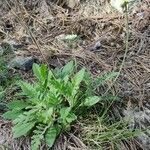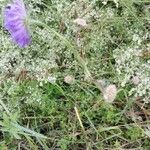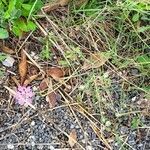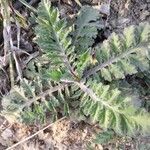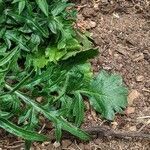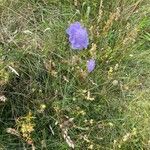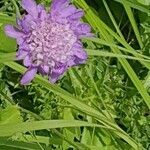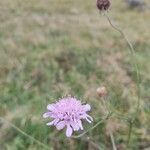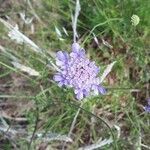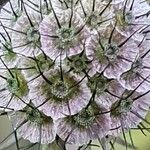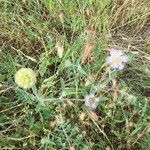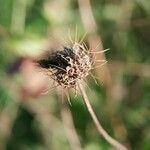A small herb. It grows 60 cm high and spreads 40 cm wide. It has a woody rootstock. The leaves are grey-green. The leaves at the base are woolly. They can have smooth edges or be deeply lobed. The upper leaves are divided into leaflets along the stalk. These are also often further divided. The flowers are in heads and are purple-blue. They are 40 mm wide. The fruit is dry. It has one seed.
Biennial or perennial 3–8 dm; basal lvs oblanceolate or obovate to lyrate; cauline lvs once or twice pinnately divided, the divisions often laciniate; heads 3 cm thick, blue, pink, or white; achenes 4 mm, deeply ribbed-sulcate; corona 1.5 mm, ca 24-veined; 2n=16. Native of Europe, n. Afr., and w. Asia, rarely adventive in our range. July–Sept.
Leaves of non–flowering rosettes and basal stem leaves ovate–lanceolate, obovate or lanceolate, simple, lyrate or pinnatifid, upper stem leaves 1–2 pinnatifid or pinnatisect, the segments lanceolate to linear, the terminal segment larger than the lateral, hispid or pubescent.
Corolla mauve or white, or the tube white and lip mauve, 5–lobed with 3 larger and 2 smaller lobes, larger and more irregularly lobed in the marginal flowers.
Involucral bracts linear lanceolate, acute, shorter than or equalling the marginal flowers, pubescent.
Flower heads on long peduncles, globular or hemispherical (2–)2·5–3·5(–4) cm. in diameter.
Involucel tube cylindrical, 8–furrowed, pubescent, 2–3·5 mm. long in fruit.
Perennial herb up to 1·5 m., with erect branched stems, heterophyllous.
Corona glabrous, membranaceous, conspicuously veined, 0·5–1·5 mm.
Calyx pilose, cupuliform, bearing 5 setae, 1–8 mm. long.
Mature fruit 2–4 mm. long, corona and calyx persistent.
Receptacle bracts linear, acute 3–5 mm. long.
